
Count Rutger von Ascheberg, also known as Roger von Ascheberg was a soldier, officer and civil servant in Swedish service, being appointed Lieutenant General in 1670, General in 1674, Field Marshal in 1678, Governor General of the Scanian provinces, in 1680, and Royal Councilor in 1681.

Carl Christopher Georg Andræ was a Danish politician and mathematician. From 1842 until 1854, he was professor of mathematics and mechanics at the national military college. He was elected to the Royal Danish Academy of Sciences and Letters in 1853. Andræ was by royal appointment a member of the 1848 Danish Constituent Assembly. In 1854, he became Finance Minister in the Cabinet of Bang before also becoming Council President of Denmark 1856-1857 as leader of the Cabinet of Andræ. After being replaced as Council President by Carl Christian Hall in 1857 Andræ continued as Finance Minister in the Cabinet of Hall I until 1858. Being an individualist he, after the defeat of the National Liberals, never formally joined any political group but remained for the rest of his life a sceptical de facto conservative spectator of the 'Constitutional Struggle'.
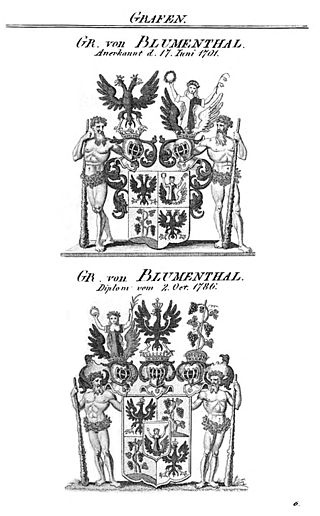
The Blumenthal family is a Lutheran and Roman Catholic German noble family, originally from Brandenburg-Prussia. Other (unrelated) families of this name exist in Switzerland and formerly in Russia, and many unrelated families called Blumenthal, without "von", are to be found worldwide.
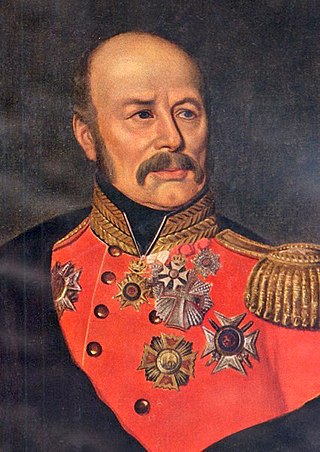
Peter Carl Frederik von Scholten was Governor-General of the Danish West Indies from 1827 to 1848.
Anthony Coucheron was an engineering officer. Coucheron played an important role in the history of Norwegian and Danish fortifications. As Sweden grew to be a great power in the 17th century, there were frequent wars in the Baltic region, and conflict was common along the borders between Sweden & Denmark-Norway. Easy invasions routes from Sweden were fortified on the Danish-Norwegian border with new or upgraded fortresses during this period, effectively establishing the modern borders between Norway & Sweden. Anthony Coucheron played a major role in fortification of the border, both in Norway and Denmark in addition, he participated with honor in combat during the Gyldenløve War.

Conrad, Count von Reventlow was a Danish statesman who was "Grand Chancellor of Denmark", a predecessor title of the Prime Minister of Denmark, from 1699 until his death. His chancellorship occurred during the reign of King Frederick IV.

Johan Cronman was a lieutenant general and the commandant of the Skåne fortress in the Swedish Empire as well as the Governor of Malmöhus County from 1727 to 1737. He was Baron of Alatskivi, Kodafer and Kokora; and Master of Vosuauer and Sattkula.
The Royal Bavarian Life Guards was a household, life guard (bodyguard) regiment of the Bavarian kings from the end of the Napoleonic Wars until the fall of the Wittelsbach monarchy and the subsequent disbanding of the Bavarian army.
Hartvig Krummedige was a Danish nobleman who was born circa 1400 in southern Jutland, Denmark and died in 1476 at Akershus Fortress, Norway.
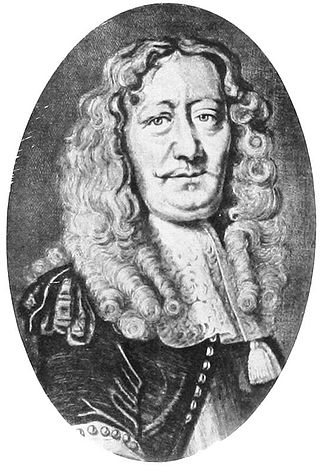
Henrik Ruse, Baron of Rysensteen was a Dutch officer and fortification engineer. Following a period when he served in various armies in Germany and Italy, he wrote a well-researched book documenting the latest trends in fortification systems across Europe. As a result, he was entrusted with commissions for improving defences in his native Amsterdam, in Germany, and finally in Denmark and Norway where, benefitting from the support of the monarchy, he first became a general and later a baron. Ruse died in Sauwerd near Groningen in the Netherlands.

The Ordre de l'Union Parfaite was created by Queen consort Sophie Magdalene of Denmark and Norway on 7 August 1732 to celebrate the tenth anniversary of her happy marriage with King Christian VI of Denmark and Norway. It was given to both men and women. Its motto was In felicissimæ Unionis Memoriam.
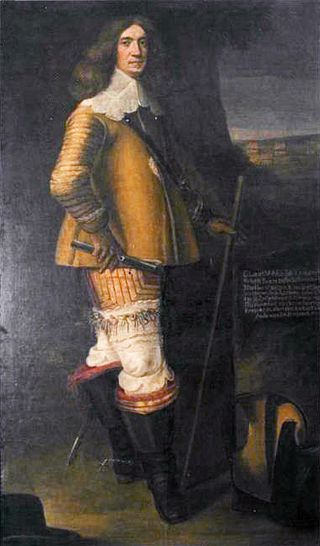
Claus von Ahlefeldt (1614–74) was a member of the Ahlefeldt noble family of Holstein, who married the King of Denmark-Norway's natural daughter and rose to become a field marshal in Danish-Norwegian service.
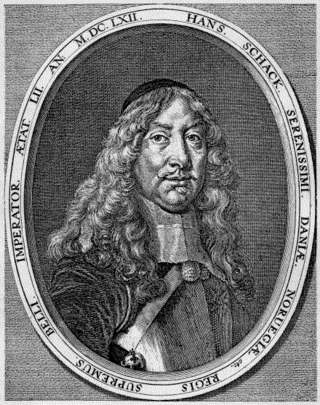
Hans Schack was a member of the north German noble family Schack, who after many years in French service, entered the Danish service, made major contributions during the war with Sweden, and loyally supported Frederick III when he overthrew the Danish constitution. He became a Danish field-marshal, commander-in-chief of the Danish army, member of the Board of State, and of the Danish Privy Council, and made a Danish count.

The Danish Auxiliary Corps was a corps of 7,000 Danish soldiers sent to fight with William of Orange who was at war in Ireland. Disappointed with his alliance with France's King Louis XIV, Christian V of Denmark–Norway in 1689 entered into a treaty of military assistance with King William III of England. The corps was transported to Ireland, fighting against the Jacobites, participating in the battles of the Boyne and Aughrim, as well as the sieges of Limerick, Cork, Kinsale, Athlone, and Galway. In early 1692 the corps was transported to Flanders for future service in English pay.
Marquess Frédéric Henri de La Forest de Suzannet was a French Huguenot in Lunenburg, Danish, and Saxon service.
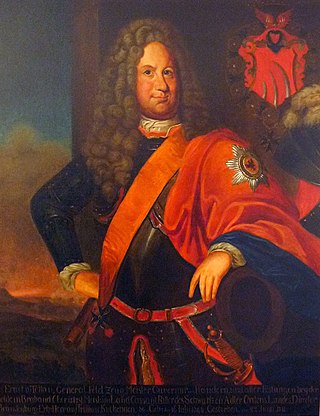
Julius Ernst von Tettau was a Brandenburg-Prussian subject serving in the Dutch, French, Danish, and Brandenburg armies, reaching general officers rank in Danish, Brandenburg, and Dutch service.
Lave Hohendorff, (1662–1729), was a Danish general officer who had served in the Danish auxiliary corpses in Ireland and in Flanders, as well as in the Danish army in the Great Northern War.
Johann Dietrich von Haxthausen , born 1652, died 1703, was one of many North German noblemen serving the King of Denmark, becoming a major-general and commander of the Danish Auxiliary Corps in Habsburg service.
Wolf Henrik von Kalnein was a Prussian noblemen in Danish service. His most notable contributions were as acting governor of the Danish colony Tranquebar in India, and as colonel in the Danish Auxiliary Corps in Ireland, where he was killed in action at the siege of Limerick.
Hartvig is a given name. Notable people with the given name include:











